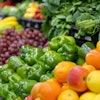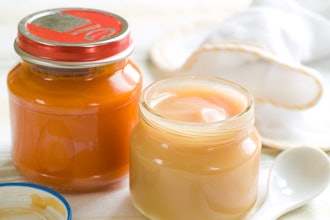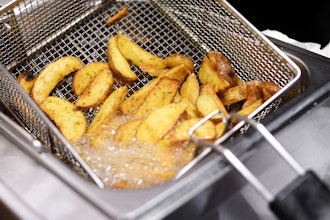SUTTONS BAY, Mich. (AP) — Apple-picking, a cherished autumn tradition, is off to an early start in the Northeast and Upper Midwest as growers deal with aftershocks from wacky spring weather that hammered fruit crops.
A series of below-freezing nights in April zapped buds that had sprouted during a rare summerlike stretch the previous month, decimating cherries, peaches and other tree fruits. While some apple orchards escaped relatively unscathed, many are producing only a small fraction of their normal output and some are coming up empty.
Michigan was hit especially hard. A harvest of perhaps 3 million bushels is expected, down from the usual 23 million or so, said executive director Diane Smith of the Michigan Apple Committee. The prolonged drought hasn't helped matters but isn't a leading cause of the drop-off, because apple trees have deep roots well-suited to reaching groundwater, she said.
The U.S. Department of Agriculture says the nationwide yield will be about 14 percent below last year's and the smallest since 1986. A slight uptick in Washington, the top apple producer, and other Western states will help grocers compensate for the decline east of the Mississippi.
Across the Great Lakes region, which includes four of the nation's top 10 apple-growing states — New York, Michigan, Pennsylvania and Ohio — fruit that survived is ripening weeks earlier than usual. It's happening in parts of New England as well. For people who enjoy visiting orchards to pick apples or stopping by a farm market to buy a bushel and a jug of cider on a crisp fall weekend, the message from growers is simple: If you wait too long, you may lose out.
"Keep an eye on your source and as soon as they get (apples), better get what you need because they will go fast," said Alan Spinniken, owner of Eagle View Farms near Suttons Bay, where a crew of migrant workers began stripping trees of a variety called "Early Gold" this week.
It's a sign of the times that Spinniken, a fourth-generation fruit farmer in Michigan's northwestern Lower Peninsula, feels fortunate despite losing about a third of his crop.
"I've got some neighbors with nothing," he said, sifting through a large crate of yellow-skinned apples, many misshapen and unusually small.
Early Golds will go to a processor and become applesauce. Spinniken expects his fresh-market varieties —McIntosh, Ida Red, Rome — to ripen by mid-September, at least two weeks ahead of schedule.
Bob Gregory, who runs nearby Cherry Bay Orchards, plans to begin harvesting next week. His crop is a mixed bag, with Galas and Honey Crisps doing reasonably well but Jonagolds and McIntoshes languishing.
"This is the worst of the worst that we've ever seen in 42 years of farming," said Gregory, who expects perhaps two-thirds of a normal crop.
Damage is heavier in southwestern Michigan, the state's top apple-producing region, where 25 to 30 percent is a respectable showing this year. Joe Klein anticipates getting 5,400 bushels from his orchard 15 miles north of Grand Rapids, only about 7 percent of his normal harvest. His slimmed-down crew of pickers is getting started about three weeks early.
Some farm market operators are buying apples from neighbors or even other states so their fall customers won't go without. But people who prefer to pick their own may be out of luck.
Erwin Orchards in Oakland County, just northwest of Detroit, announced on its website the orchard was bare. "This is unlike any other season we have had in our U-Pick history," it said, adding that "we should be able to obtain enough apples so that we can have apple cider available for your enjoyment."
In New York, the second-ranking apple producer after Washington state, harvesting is under way in the Hudson Valley — up to two weeks earlier than usual.
Pickers started harvesting Paula Reds and Ginger Golds last week on Karen Resinger's farm in Watkins Glen, N.Y.
"The season is early, and I think everything is going to be picked out early," she said.
Farmers who fared best during the April freeze tended to have orchards on higher ground, where the air was slightly warmer than in valleys, said Amy Irish-Brown, a Michigan State University extension educator.
Those who could afford it placed huge fans or propane heaters amid their trees. Some even hired helicopters to hover above the orchards, hoping the breezes they kicked up would push warm air closer to the ground — enough to raise the temperature just a degree or two.
"Sometimes that's all you need to prevent a total crop loss," Irish-Brown said.
Even as orchard operators salvage what they can, fickle weather remains a concern.
Steve Louis began harvesting early varieties this month on his farm 60 miles northwest of Madison, Wis. Thanks to its hilltop location, he's doing considerably better than the statewide average yield, expected to be perhaps 80 percent below normal. But his apples have suffered from the drought and storms are a constant threat.
"I was talking to a big grower in Pennsylvania who had a nice crop ... but then a hailstorm went through and took it out," Louis said. "It's like Mother Nature is not going to stop until it's all gone this year."
___
Associated Press writers Mike Householder in Detroit, George Walsh in Albany, N.Y., and Lisa Rathke in Montpelier, Vt., contributed to this story.






















